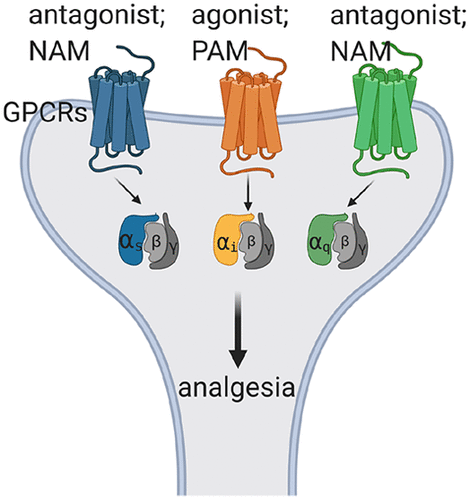当前位置:
X-MOL 学术
›
Biochemistry
›
论文详情
Our official English website, www.x-mol.net, welcomes your feedback! (Note: you will need to create a separate account there.)
Advances in the Treatment of Chronic Pain by Targeting GPCRs
Biochemistry ( IF 2.9 ) Pub Date : 2020-11-13 , DOI: 10.1021/acs.biochem.0c00644 Tao Che 1, 2
Biochemistry ( IF 2.9 ) Pub Date : 2020-11-13 , DOI: 10.1021/acs.biochem.0c00644 Tao Che 1, 2
Affiliation

|
Pain is an essential protective mechanism that the body uses to alert or prevent further damage. Pain sensation is a complex event involving perception, transmission, processing, and response. Neurons at different levels (peripheral, spinal cord, and brain) are responsible for these pro- or antinociceptive activities to ensure an appropriate response to external stimuli. The terminals of these neurons, both in the peripheral endings and in the synapses, are equipped with G protein-coupled receptors (GPCRs), voltage- and ligand-gated ion channels that sense structurally diverse stimuli and inhibitors of neuronal activity. This review will focus on the largest class of sensory proteins, the GPCRs, as they are distributed throughout ascending and descending neurons and regulate activity at each step during pain transmission. GPCR activation also directly or indirectly controls the function of co-localized ion channels. The levels and types of some GPCRs are significantly altered in different pain models, especially chronic pain states, emphasizing that these molecules could be new targets for therapeutic intervention in chronic pain.
中文翻译:

靶向 GPCRs 治疗慢性疼痛的进展
疼痛是身体用来提醒或防止进一步损害的重要保护机制。痛觉是一个涉及感知、传递、加工和反应的复杂事件。不同层次(外周、脊髓和大脑)的神经元负责这些促或抗伤害感受的活动,以确保对外部刺激做出适当的反应。这些神经元的末梢,无论是在外周末梢还是在突触中,都配备了 G 蛋白偶联受体 (GPCR)、电压门控和配体门控离子通道,可感知结构不同的刺激和神经元活动的抑制剂。本综述将重点关注最大的一类感觉蛋白 GPCR,因为它们分布在整个上行和下行神经元中,并在疼痛传递过程中的每一步调节活动。GPCR 激活还直接或间接控制共定位离子通道的功能。一些 GPCR 的水平和类型在不同的疼痛模型中发生了显着变化,尤其是慢性疼痛状态,强调这些分子可能成为慢性疼痛治疗干预的新靶点。
更新日期:2020-11-13
中文翻译:

靶向 GPCRs 治疗慢性疼痛的进展
疼痛是身体用来提醒或防止进一步损害的重要保护机制。痛觉是一个涉及感知、传递、加工和反应的复杂事件。不同层次(外周、脊髓和大脑)的神经元负责这些促或抗伤害感受的活动,以确保对外部刺激做出适当的反应。这些神经元的末梢,无论是在外周末梢还是在突触中,都配备了 G 蛋白偶联受体 (GPCR)、电压门控和配体门控离子通道,可感知结构不同的刺激和神经元活动的抑制剂。本综述将重点关注最大的一类感觉蛋白 GPCR,因为它们分布在整个上行和下行神经元中,并在疼痛传递过程中的每一步调节活动。GPCR 激活还直接或间接控制共定位离子通道的功能。一些 GPCR 的水平和类型在不同的疼痛模型中发生了显着变化,尤其是慢性疼痛状态,强调这些分子可能成为慢性疼痛治疗干预的新靶点。



























 京公网安备 11010802027423号
京公网安备 11010802027423号